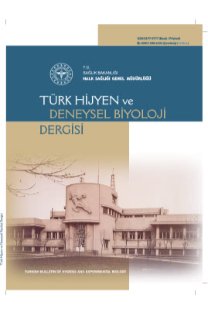Su örneklerinde norovirüs varlığının cross-flow mikrofiltrasyon ve RT-PCR ile belirlenmesi
su, norovirüs, filtrasyon, RT-PCR
Determination of norovirus in water samples by cross-flow microfiltration and RT-PCR
water, norovirus, filtration, RT-PCR,
___
- 1. Anonymous. Gastroenteritler. T.C. Sağlık Bakanlığı, THSK, Bulaşıcı Hastalıkları Daire Başkanlığı. http://thsk.gov.tr/tr/index.php/su-ve-besinlerlebulasan-hastaliklar/369-gastroenterit_ishal, (Erişim Tarihi: 03.02.2014).
- 2. Reynolds K, Mena K, Gerba C. Risk of waterborne illness via drinking water in the United States. Rev Environ Contam Toxicol, 2008; 192: 117-58.
- 3. Siebenga JJ, Vennema H, Zheng DP, Vinjé J, Lee BE, Pang XL, et al. Norovirus illness is a global problem: emergence and spread of norovirus GII. 4 variants, 2001-2007. J Infect Dis, 2009; 200 (5): 802-12.
- 4. Korukoğlu G, Çağlayık-Yağcı D. Viral gastroenteritlerin laboratuvar tanısı. www.klimik. org.tr/wp-content/uploads/2013/01/20.01.2013- GÜLAY-KORUKOĞLU-dıç.pdf, (Erişim Tarihi: 26.11.2013).
- 5. Kireçci E, Özer A. Norovirüsler, salgınları ve mücadele. Van Tıp Derg, 2011;18 (1): 49-56.
- 6. Yap J, Qadir A, Liu I, Loh J, Tan BH, Lee VJ. Outbreak of acute norovirus gastroenteritis in a military facility in Singapore: a public health perspective. Singapore Med J, 2012; 53 (4): 249-54.
- 7. Xue C, Fu Y, Zhu W, Fei Y, Zhu L, Zhang H, et al. An outbreak of acute norovirus gastroenteritis in a boarding school in Shanghai: a retrospective cohort study. BMC Public Health, 2014; 14: 1092.
- 8. Kauppinen A, Al-Hello H, Zacheus O, Kilponen J, Maunula L, Huusko S, et al. Increase in outbreaks of gastroenteritis linked to bathing water in Finland in summer 2014. Euro Surveill, 2017; 22 (8): 1-8.
- 9. Pasco E. Virus concentration by crossflow membrane filtration: effect of hydrodynamic conditions and membrane properties. Doctoral Dissertation, Michigan State University, 2012.
- 10. Laverick MA, Wyn-Jones AP, Carter MJ. Quantitative RT-PCR for the enumeration of noroviruses (Norwalk-like viruses) in water and sewage. Lett Appl Microbiol, 2004, 39: 127–36.
- 11. Tong HI, Connell C, Boehm AB, Lu Y. Effective detection of human noroviruses in Hawaiian waters using enchanced RT-PCR methods. Water Res, 2011; 45 (18): 5837-48.
- 12. Zhou X, Li H, Sun L, Mo Y, Chen S, Wu X, et al. Epidemiological and molecular analysis of a waterborne outbreak of norovirus GII.4. Epidemiol Infect, 2012; 140 (12): 2282-9.
- 13. Gregory JB, Webster LF, Griffith JF, Stewart JR. Improved detection and quantitation of norovirus from water. J Virol Methods, 2011; 172 (1-2): 38- 45.
- 14. Ramírez-Castillo FY, Loera-Muro A, Jacques M, Garneau P, Avelar-González FJ, Harel J, et al. Waterborne Pathogens: Detection Methods and Challenges. Pathogens, 2015; 4 (2): 307–34.
- 15. Tian P, Yang D, Pan L, Mandrella R. Application of a receptor-binding capture quantitative reverse transcription-PCR assay to concentrate human norovirus from sewage and to study the distribution and stability of the virus. Appl Environ Microbiol, 2012; 78 (2): 429-36.
- 16. Francy DS, Stelzer EA, Brady AMG, Huitger C, Bushon RN, Ip HS, et al. Comparison of filters for concentrating microbial indicators and pathogens in lake water samples. Appl Environ Microbiol, 2013; 79 (4): 1342–52.
- 17. Lodder WJ, van den Berg HHJL, Rutjes SA, de Roda Husman AM. Presence of enteric viruses in source waters for drinking water production in the Netherlands. Appl Environ Microbiol, 2010;76 (17): 5965-71.
- ISSN: 0377-9777
- Yayın Aralığı: 4
- Başlangıç: 1938
- Yayıncı: Türkiye Halk Sağlığı Kurumu
Sağlık Kuruluşlarının Su Kullanım Etkinliklerinin İller Düzeyinde Belirlenmesi
Gül İMAMOĞLU, Yıldız KÖSE, Emrullah DEMİRCİ
Türkiye'nin su ayak izi değerlendirmesi
Esra ÖZKAYA, Kurtuluş BURUK, Neşe KAKLIKKAYA, İlknur TOSUN
Tekirdağ İlinde Klorlama İşlemlerinin Yönetimi ve Sürdürülmesi
Şafak BAŞA, İbrahim İÇÖZ, Deniz AKTAŞ
Huzurevi ve evde kalan yaşlılarda su tüketimi ve ilişkili faktörlerin belirlenmesi
Gamze MUZ, Kamuran ÖZDİL, Gülyeter ERDOĞAN, Fatma SEZER
Trabzon ili Ortahisar ilçesindeki kafe / restoranlarda su kullanımı ve tüketimi
İrem DİLAVER, Yusuf DEMİRTAŞ, Murat TOPBAŞ, Sertaç ÇANKAYA, Serdar KARAKULLUKÇU, Gufran ACAR, Büşra PARLAK, Kübra ŞAHİN, Gamze ÇAN, Nazım Ercüment BEYHUN
Arda BORLU, Elçin BALCI, Ahmet ÖZTÜRK
Yasemin DURDURAN, Mehmet UYAR, Yusuf Kenan BOYRAZ, Lütfi Saltuk DEMİR, Özlen TEKİN, Tahir Kemal ŞAHİN
Gönül Tuğrul İÇEMER, Yasemin Büşra BAYRAK ÇAMLICA, Tuğçe ATICI
Özkan YAŞAYANCAN, Cihat ZÜLFÜOĞULLARI, Esra Ser DEMİR, Seyhan ÖZELCE
